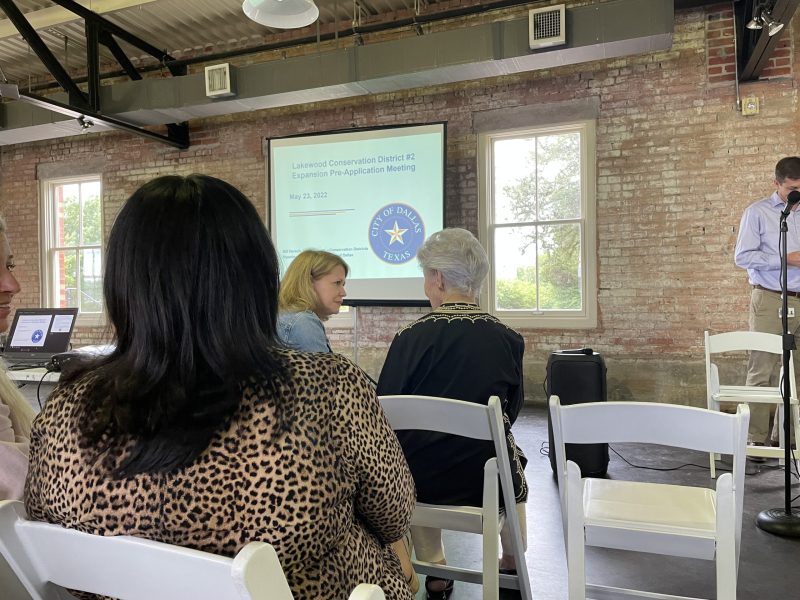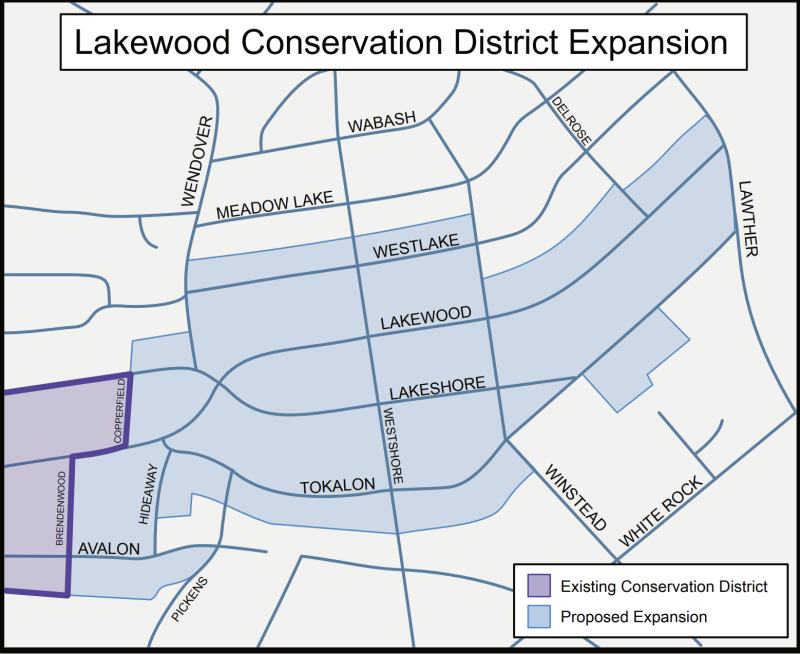
The first pre-application meeting for the Lakewood Conservation District No. 2 Expansion was held May 23, 2022, at the Filter Building on White Rock Lake. Photo by Renee Umsted.
Lakewood residents shared messages of support and opposition at the first pre-application meeting for creating a new conservation district.
Neighbors in the existing Lakewood Conservation District, which was founded in 1988, and those who live in the proposed expansion area were invited to the meeting held at the Filter Building near White Rock Lake. The purpose of the meeting was to learn more about conservation districts and the process to create a new conservation district.
A neighborhood committee of 10 residents in the proposed expansion area met in February to talk about protecting the character of the neighborhood through a conservation district, which is a change in zoning. City staff from Planning and Urban Design approved the determination of eligibility in April, and later that month, petitions were provided to the neighborhood committee.
The neighborhood committee has until June 27 to get petitions signed by owners of 58% of the lots or 58% of the land in the proposed area. Signing the petition signals a willingness to continue the process and engage in discussions about how to regulate architectural and developmental styles.
If the neighborhood committee receives enough signatures and submits the petitions and application on time, and if City staff verify the petitions, the post-application meetings will begin.
There will likely be at least four post-application meetings, says Bill Hersch, the chief planner for conservation districts at the City of Dallas. Neighbors will then discuss what they want to regulate and how they want to regulate those items. City staff will take into consideration what they hear from neighbors in the proposed area, draft an ordinance with the desired regulations and submit it to residents for feedback.
“This is a completely neighborhood-driven process,” Hersch says.
Though this is called an expansion, the proposed conservation district would have its own ordinance. It could have similar elements to the existing Lakewood Conservation District, but it doesn’t have to.
While some meeting attendees were in favor of creating the conservation district, others were skeptical.
Eric Kraft, who lives in a Clifford Hutsell-designed home in the proposed expansion area, says he loves historical homes. But he is wary of the “bureaucracy” that residents may face when they want to make changes to their homes.
“I am not in favor of regulations that overlay what we can and cannot do with our property,” Kraft says. “This is about tear downs. This is about people who are not happy with what’s been built around them. I understand that’s what we’re trying to do, is make it better. But you cannot take regulations and control the aesthetics of a building. You can’t make it pretty. Everybody’s view of aesthetics is different.”
There are some aspects of architectural and developmental styles that must be regulated; these include density, fences, lot coverage, setbacks, stories, building elevation, building materials, porch styles, windows, chimneys and more.
But the City does not dictate how each of these is regulated. That’s up to neighbors.
There are also features that may be regulated, such as building width, demolition, driveways, foundations, garage locations, landscaping, paint colors and more. What specifically about each of those are regulated is determined by residents.
Another neighbor who doesn’t want to live in a conservation district asked about changing the boundaries of the proposed area. Hersch says the neighborhood committee delineated the boundaries based on compatible architectural and developmental standards, and the City approved them. At this point, the only way to change the boundaries is to get the City Plan Commission to authorize a public hearing.

Proposed expansion area for Lakewood CD. Map courtesy of City of Dallas.
The proposed area includes 275 homes: 89 Tudor, 54 Spanish eclectic, 14 French eclectic, 11 minimal traditional, 5 neoclassical, 26 colonial revival and 76 undefined.
Other meeting attendees were concerned about how a conservation district would affect the value of their homes.
Hersch says there isn’t a lot of data to reference for this type of zoning, but there is for historic districts, which are similar to conservation districts.
In historic districts, values increase, just not as quickly as in other types of zoning, Hersch says. And if there’s an economic depression, the values don’t drop as much.
“What a conservation district is, is about conserving character in your neighborhood,” Hersch says. “It’s not about making sure my house is worth double what it was last year or making sure that it doesn’t drop into the toilet whenever the bottom falls out of this housing market. What it’s about is ensuring that as you walk through your neighborhood that you’re not seeing garish new development, that things are fitting in with the neighborhood.”





